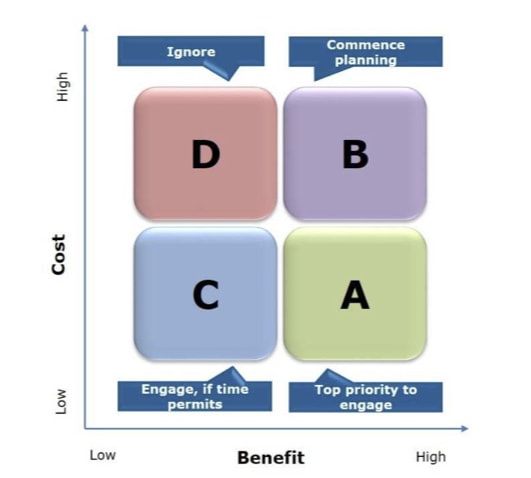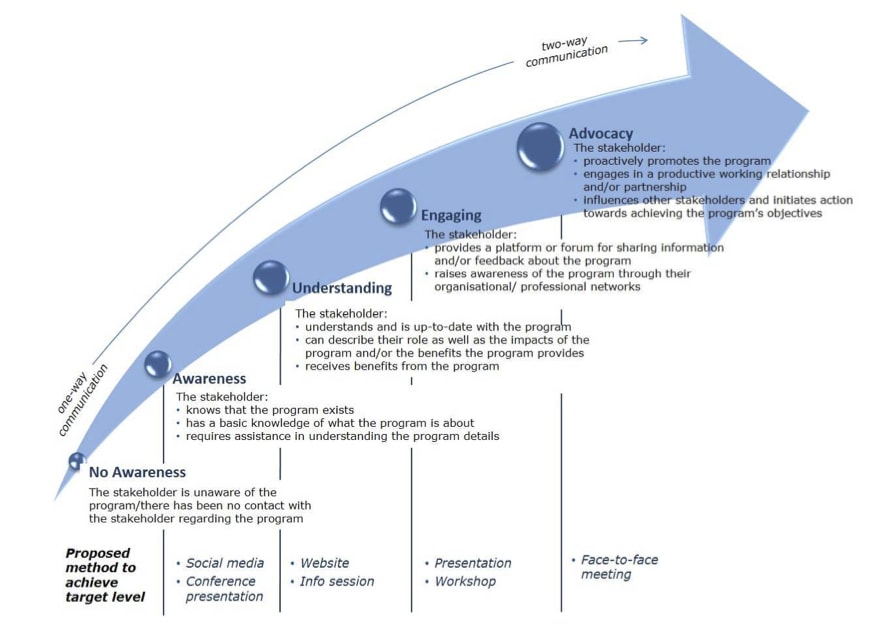The key to effective stakeholder engagement

Stakeholder engagement plan
It’s no secret that effective and efficient stakeholder engagement is a key element to the success of any organisation.
Every day, organisations communicate with a wide range of internal and external stakeholders in every aspect of their operations. However, when analysing our clients’ stakeholder engagement approaches, it becomes evident that efforts to engage with stakeholders often occur in an ad-hoc and rather visceral manner. We observed that organisations who report poor results from stakeholder engagement activities are either insufficiently or disproportionately resourced with unclear goals and a lack of strategic direction. Lessons learned from past communication efforts are also not formally captured and/or widely shared. The approaches regularly lack appropriate planning and coherence across the organisation.
As a result, the tremendous potential derived from meaningful stakeholder engagement and the subsequently developed relationships is under-utilised. The entity’s reputation, as well as a program or project results, may also be at risk. A strategic and consistent approach, supported by a plan with clear objectives and a customised-engagement process, increases benefits for your organisation and stakeholders. Below are some of the considerations of what it means to apply a strategic and consistent approach to stakeholder engagement. It includes two examples of proven tools that foster a more systematic and concerted pursuit.
A tight fiscal environment coupled with limited resource availability for stakeholder engagement underlines the need for efficient and cost-effective engagement activities. It is therefore more important than ever when engaging stakeholders to take a strategic and concerted approach.
Prioritise who to engage
The first step of the engagement process involves identifying the stakeholders that ought to be the focus of the organisation’s engagement efforts over a specific period of time.
Prioritising who to engage with can be informed by a simple cost-benefit analysis. Consider the reasons, benefits and strategic alignment for engaging with the stakeholder, eg:
- why should we engage with the stakeholder?
- what do we hope to achieve from this engagement?
- how does this engagement align with our strategic and/or operational objectives?
Other considerations include:
- availability of resources (human and budget)
- time and effort required for the engagement
- current and/or past activities undertaken to engage this stakeholder (including lessons learned).
A common approach to undertaking this is depicted below. Stakeholders falling into the A quadrant are of highest priority. Stakeholders falling into D are lowest priority.
Figure 1: Stakeholder Quadrant

A strategic approach also means being smart about who to engage with. For example, if the program’s aim is to increase participation, targeting your efforts towards engaging stakeholders with the largest reach and most connections with potential participants (sometimes referred to as multipliers), will optimise the use of your resources.
Spend the right amount of time, effort and money on the engagement
There are a wide range of stakeholders that have varying levels of ability to impact the achievement of the objectives of the organisation, the program or a particular project, and with diverse needs and interests. Therefore, you should ask yourself:
“What and how many resources should we actually spend on the engagement?”
This involves determining:
a) what is the current engagement level with that stakeholder?
b) what is the desired future engagement level?
Figure 2 is an example of a five-level engagement scale, ranging from ‘no awareness’ of a program to ‘advocacy’, where the stakeholder is participating in a mutual partnership with the organisation. This tool gives guidance for determining current and future engagement levels.
It should be noted that the target level will vary between different stakeholders; ie, it would not be necessary for all stakeholders to reach an ‘advocacy’ level. Each engagement level is also linked to a selection of engagement activities and methods, informing not only the type but also the amount of effort required.
Identifying the proposed method to achieve the target level of engagement will help an organisation to identify and cost the resources necessary for the engagement process.
Figure 2: Five Level Engagement Scale

Note: Figure 2 provides examples and starting points only and has to be tailored to the particular organisation, program or project to be effective.
A consistent approach
Making decisions around stakeholder engagement in a consistent manner across the organisation is of fundamental importance to ensure high-quality and reliable results. This can be achieved through embedding stakeholder engagement into everyday business activities. Implementing and employing an appropriate stakeholder engagement framework will assist with this task.
Communicate consistent messages
Managing the messages stakeholders receive is crucial to ensuring that the organisation is meeting the expectations of stakeholders and achieving its objectives. It also ensures stakeholders interact with a unified organisation that is clear on its purpose and intentions.
One way of improving consistency is through establishing and/or reviewing all currently publicly available material to ensure that marketing and other relevant documents:
- contain consistent messaging and align with the organisation’s objectives
- work to support the objectives of the organisation’s stakeholder engagement framework and other marketing/communication strategies and plans
- meet the identified needs of stakeholders
- align with the target engagement levels (outlined on the previous page).
Develop your own strategic approach
In many instances stakeholder engagement is nothing new to the organisation. There is plenty of literature available on how to engage with stakeholders. However, developing a strategically tailored approach with a robust and consistently applied stakeholder engagement process, leads to a more effective engagement.







 We are all about sharing our expertise to help you and your organisation be the best it can be.
We are all about sharing our expertise to help you and your organisation be the best it can be.